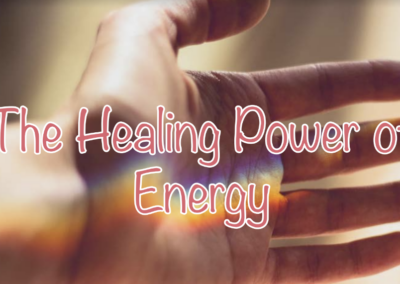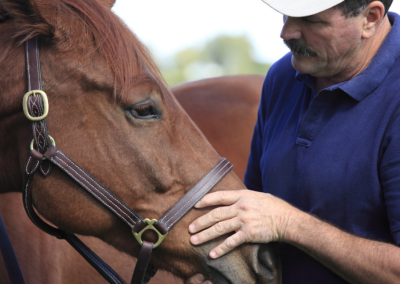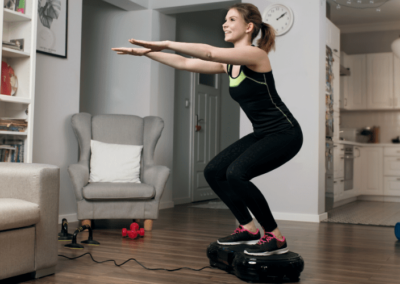As humans, we’ve long acknowledged the healing power of touch, but can this power extend to our equine companions? In equine therapy, the Masterson Method is garnering attention for doing just that, revolutionizing how we interact with and understand these noble animals.
This article provides a comprehensive dive into the intriguing world of the Masterson Method, an innovative form of equine bodywork that promotes healing, improves performance, and fosters a deep connection between horse and handler. Unlike traditional horse massage that applies direct pressure, the Masterson Method is a unique, interactive approach based on the horse’s responses to touch.
The importance of equine therapy has become increasingly recognized in recent years and for a good reason. Therapy methods, such as the Masterson Method, don’t just contribute to horses’ physical health. They also improve their emotional well-being and performance, leading to a more balanced and harmonious relationship between horses and humans.
The Masterson Method: A Path to Equine Harmony

What exactly is the Masterson Method? At its core, it’s an innovative form of equine bodywork that facilitates communication and connection between horse and handler, leading to improved performance and well-being for the horse. Developed by Jim Masterson, this technique stands apart from traditional equine massage and physiotherapy due to its uniquely interactive and integrated approach.
Unlike conventional horse massage techniques, which apply direct pressure to the horse’s body, the Masterson Method is more subtle and involves light touch and gentle movements. The handler watches and responds to the horse’s reactions, making adjustments based on these responses. By recognizing and interpreting the horse’s visual and palpable responses, practitioners of the Masterson Method can identify areas of tension, strain, or discomfort in the horse’s body and work to release them, thus promoting relaxation, enhancing mobility, and improving overall performance.
The Masterson Method was born out of Jim Masterson’s experiences working with performance horses, specifically in the competitive equestrian circuit. Observing these horses’ stresses and strains, Masterson began exploring ways to alleviate their tension and improve their well-being. His work as the U.S. Endurance Team’s official equine massage therapist further refined his approach and techniques. Over time, his unique bodywork evolved into what we now know as the Masterson Method, a practice that has since been embraced by horse owners, trainers, and therapists worldwide.
The effectiveness of the Masterson Method is rooted in its respect for the horse as a sentient being, acknowledging its ability to communicate its physical sensations and needs. This mutual interaction creates a bond of trust and understanding between the horse and the handler, enhancing the horse’s physical and emotional well-being.
Through its unique approach to equine therapy, the Masterson Method stands as a testament to the remarkable relationship between humans and horses, highlighting our ability to communicate, connect, and heal through a shared language of touch and response.
How the Masterson Method Works

The Masterson Method operates on the premise that horses, just like humans, respond to touch and can communicate their physical sensations through subtle cues. This understanding forms the bedrock of the Masterson Method and guides its approach to equine therapy. But how does this technique work in practice? Let’s delve deeper into the principles, touch-and-response aspect, and the role of equine anatomy and physiology in the Masterson Method.
The Principles Behind the Masterson Method
The Masterson Method focuses on three primary principles: the ‘Light Touch,’ ‘Search, Response and Stay,’ and ‘Bladder Meridian Technique.’
The ‘Light Touch’ involves using a touch so light that it doesn’t elicit a resisting response from the horse. This non-invasive approach allows the handler to bypass the horse’s natural instinct to guard or protect itself, enabling deeper relaxation and tension release.
The ‘Search, Response and Stay’ principle builds on this light touch approach. The handler ‘searches’ for areas of tension in the horse’s body using gentle palpation. When the handler identifies a response – such as a head toss, eye blink, or muscle twitch – they ‘stay’ in that area, maintaining light touch until the horse relaxes and releases the tension.
The ‘Bladder Meridian Technique’ is another unique aspect of the Masterson Method. This technique involves tracing a particular acupressure meridian (the Bladder Meridian) down the horse’s body, starting from the poll, down the neck, back, and tail. It’s used to identify areas of tension, discomfort, or blocked energy.
The Touch and Response Aspect of the Method
The touch-and-response aspect of the Masterson Method can’t be overstated. Every touch is a conversation, an opportunity to communicate and connect with the horse. By observing the horse’s responses to touch – whether through physical reactions, facial expressions, or changes in breathing – the handler can identify and address areas of tension or discomfort, leading to relief, relaxation, and enhanced performance.
The Role of the Horse’s Anatomy and Physiology in the Method
Understanding the horse’s anatomy and physiology is vital for applying the Masterson Method effectively. Knowledge of the muscular and skeletal structure and the neurological and circulatory systems informs the handler’s approach, helping them understand where to look for common stress points, how to interpret the horse’s responses, and how to facilitate tension release.
For instance, the horse’s neck and back contain several muscles, ligaments, and joints that can hold tension, affecting the horse’s movement and performance. By understanding the interplay of these anatomical elements, the handler can more effectively apply the Masterson Method techniques, ultimately benefiting the horse’s well-being and performance.
The Masterson Method represents a holistic, integrated approach to equine bodywork. It is grounded in the principles of light touch, attentive response, and a deep understanding of equine anatomy and physiology. The method’s effectiveness lies not just in the hands of the handler but also in the horse’s responses, making it a truly interactive and mutually beneficial practice.
Common Uses of the Masterson Method

The application of the Masterson Method extends beyond mere touch and interaction with horses; it has profound implications for their physical well-being, emotional health, and performance. Let’s examine some of the most common uses of this innovative technique, from aiding in rehabilitation and therapy to boosting performance and enhancing general wellness.
Rehabilitation and Therapy for Injured or Abused Horses
For injured or abused horses, the Masterson Method can serve as a gentle and effective form of therapy. Given its non-invasive approach, it provides a safe means to aid in the recovery process. Through attentive touch, practitioners can pinpoint areas of tension or discomfort that might be related to an injury, enabling targeted therapy. For abused horses, the method’s emphasis on gentle touch and response fosters trust and connection, crucial components in healing and rehabilitation.
Performance Improvement for Racing and Show Horses
Peak performance is key in the competitive world of racing and show jumping. The Masterson Method has been shown to enhance performance by helping horses maintain optimal physical conditions. The method can improve flexibility, balance, and movement efficiency by releasing accumulated tension in the muscles and connective tissues. Moreover, its stress-relieving effects can contribute to better focus and a more positive mindset, both essential elements for success in high-pressure competitive environments.
General Horse Wellness and Stress Reduction
Even for horses not actively involved in racing or show jumping, the Masterson Method has significant benefits. It contributes to general horse wellness by promoting relaxation, reducing stress, and improving overall body function. Regular sessions can prevent the build-up of tension, reduce the risk of injuries, and promote a more harmonious relationship between the horse and its handler. The method also encourages mental well-being, as the gentle touch and interaction can ease anxiety and promote a sense of calm in the horse.
Mastering the Masterson Method: Tools and Resources for Learning
While nuanced and sophisticated, the practice of the Masterson Method is accessible to horse owners, handlers, and enthusiasts willing to learn. This section will explore the tools commonly used in the Masterson Method and the various resources available for learning this unique approach to equine therapy.
Common Tools and Devices in the Masterson Method
Interestingly, one of the distinguishing features of the Masterson Method is its minimal reliance on specialized equipment. The primary tool is the practitioner’s hands, used to apply gentle touch and palpate for areas of tension or discomfort. However, certain tools can assist in applying the method, especially in harder-to-reach areas or when more pressure is needed. These may include gentle grooming tools like soft brushes for promoting relaxation and connection.
Professional Courses, Books, and Online Resources
For those interested in learning the Masterson Method, a variety of resources are available. In-person and online professional courses offer comprehensive training in the technique. Jim Masterson himself offers a series of courses through The Masterson Method® Equine Performance Bodywork Program. These include weekend seminars, five-day practical courses, and advanced technique workshops.
For self-paced learning, Jim Masterson’s book “Beyond Horse Massage: A Breakthrough Interactive Method for Alleviating Soreness, Strain, and Tension” provides a detailed, step-by-step guide to the Masterson Method. The book is richly illustrated, making it a valuable resource for both beginners and those with prior experience in equine massage.
Online resources are also plentiful. The Masterson Method’s official website provides a wealth of information, including instructional videos, webinars, case studies, and articles. Additionally, online forums and social media groups offer platforms for sharing experiences and asking questions, creating a community of learners and practitioners.
Precautions and Contraindications of the Masterson Method
While the Masterson Method is generally considered safe and beneficial for most horses, it’s important to understand that there are certain circumstances when it may not be appropriate or when it should be used with caution. Let’s delve into the precautions and contraindications of the Masterson Method for both the handler and the horse.
When to Avoid Using the Masterson Method
The Masterson Method should not be used in cases of acute injuries, severe illnesses, or if the horse is showing signs of extreme distress or discomfort. It’s crucial to remember that the Masterson Method does not replace veterinary care. If a horse is unwell or injured, the first point of contact should always be a veterinary professional.
Also, it may be best to avoid the method immediately before an intense training session or competition. While the Masterson Method can help release tension and improve performance, the relaxation it induces might temporarily reduce the horse’s energy levels and responsiveness.
Safety Precautions for Both the Handler and the Horse
Safety is paramount when practicing the Masterson Method. For the handler, understanding the basics of horse behavior and body language is crucial to avoid accidental injuries. Remember, horses are large, powerful animals that can react unpredictably when uncomfortable or scared.
For the horse, the handler must always maintain a gentle and respectful approach. Applying too much pressure, rushing the process, or ignoring the horse’s signals can cause discomfort or even injury. The Masterson Method is based on mutual trust and respect; these principles should guide every interaction.
Making a Choice: The Masterson Method vs. Other Modalities
Choosing the right therapy modality for your horse can be a challenging decision. Given the variety of techniques available, it’s important to consider your horse’s unique needs and circumstances. This section will provide guiding questions to help determine if the Masterson Method is the right choice for your horse and compare this method with other common equine therapy modalities.
Guiding Questions to Help Determine if the Masterson Method is Right for Your Horse
When considering the Masterson Method, it’s helpful to ask:
- What is my primary goal for my horse’s therapy? Is it rehabilitation, performance enhancement, or general wellness?
- How does my horse typically respond to touch? Is my horse sensitive or resistant to traditional massage techniques?
- Am I willing to invest time in learning a new method and applying it regularly?
- Would my horse benefit from a therapy method that promotes mental as well as physical well-being?
If your goal is general wellness, stress reduction, or performance enhancement, and your horse responds well to gentle touch, the Masterson Method could be a good fit. The method is particularly beneficial for horses sensitive to traditional massage techniques or those who would benefit from a method promoting physical and mental well-being.
Comparison of the Masterson Method with Other Horse Therapy Modalities
Several equine therapy modalities exist, each with its own strengths and approaches. For instance, traditional equine massage therapy uses more direct pressure and typically focuses on muscle groups, while chiropractic care targets the alignment of the horse’s skeletal system. Acupuncture, another modality, relies on inserting thin needles into specific points to stimulate healing and relieve pain.
The Masterson Method differs from these techniques in its approach and philosophy. It uses light touch rather than direct pressure or invasive techniques and incorporates the horse’s responses to guide the therapy process. This method also goes beyond focusing on a single physical aspect, such as muscles or bones, and instead views the horse as an integrated being, considering its physical, emotional, and neurological well-being.
Frequently Asked Questions
Does your horse seem to have muscle stiffness, reduced flexibility, or other physical discomforts?
If your horse displays signs of muscle stiffness, reduced flexibility, or other physical discomforts, the Masterson Method could be a beneficial addition to its care regimen. This therapy method uses light touch to identify and release areas of tension in the horse’s body, thereby improving flexibility and alleviating discomfort. Always consult with a veterinary professional if your horse is experiencing physical discomfort to ensure appropriate care and treatment.
Do you want to improve your horse’s performance in shows or races?
The Masterson Method can be a valuable tool for enhancing your horse’s performance in shows or races. By releasing tension and promoting overall physical wellness, this method can lead to improved movement efficiency, flexibility, and balance, all of which can contribute to better performance. Moreover, its stress-relieving effects can lead to a more focused and positive mindset, which is important for success in high-pressure competitive environments.
Are you looking for a method that encourages better connection and communication between you and your horse?
The Masterson Method is designed to foster a deeper connection and communication between the handler and the horse. By using touch as a form of communication, this method encourages mutual understanding and trust, strengthening the bond between you and your horse. Moreover, observing and responding to your horse’s cues during the therapy process can enhance your understanding of your horse’s unique needs and behaviors.
Is your horse recovering from an injury or trauma and needs a gentle, non-invasive therapy method?
For horses recovering from injury or trauma, the Masterson Method can provide a gentle and non-invasive form of therapy. It can aid in the rehabilitation process by releasing tension and promoting relaxation. However, it’s essential to note that the Masterson Method should not replace professional veterinary care. Always consult with your veterinarian before beginning any new therapy program for a horse that is recovering from injury or trauma.







